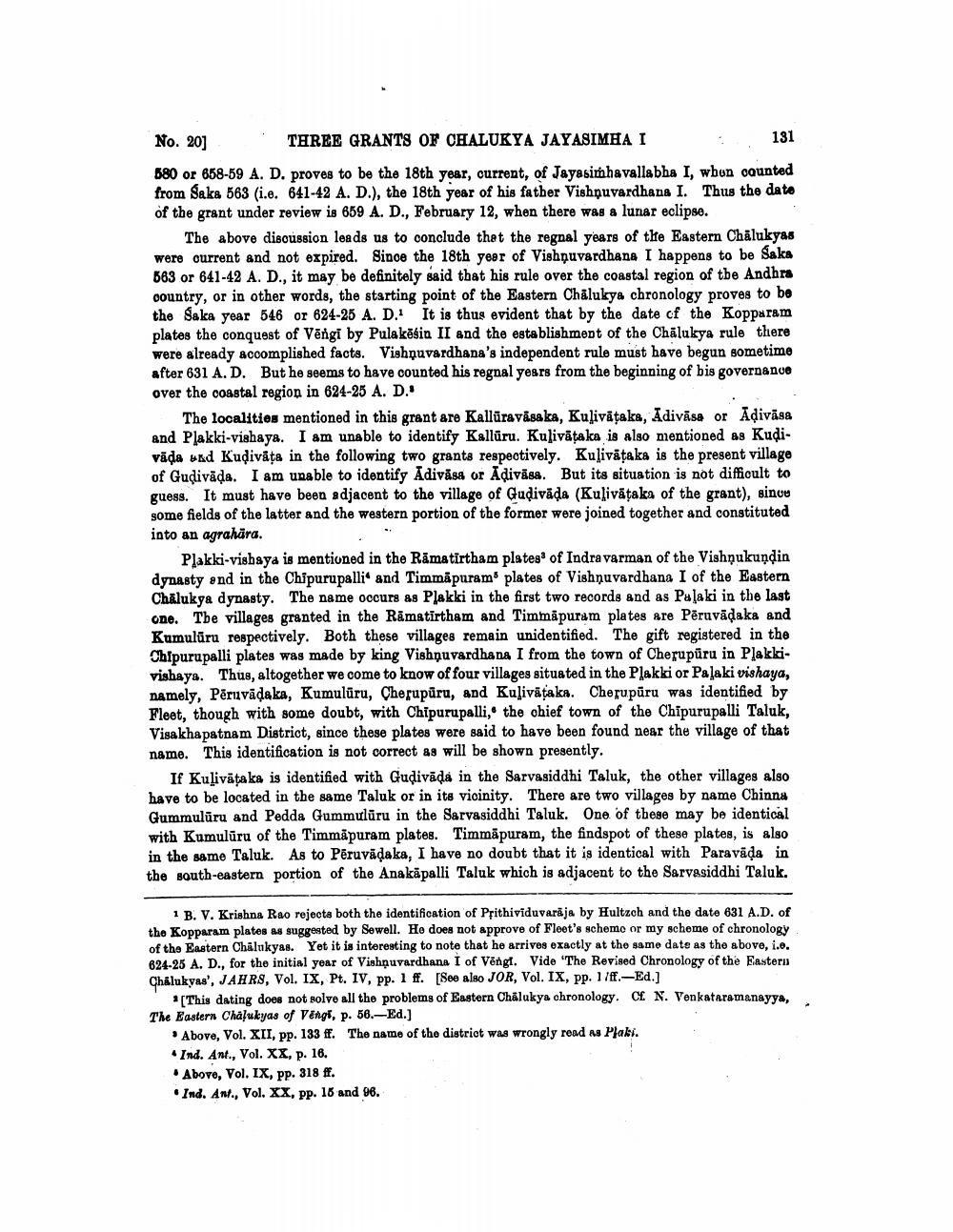________________
No. 20] THREE GRANTS OF CHALUKYA JAYASIMHA I . 131 680 or 658-59 A. D. proves to be the 18th year, current, of Jayasimhavallabha I, whun counted from Saka 563 (i.e. 641-42 A. D.), the 18th year of his father Vishnuvardhana I. Thus the date of the grant under review is 659 A. D., February 12, when there was a lunar eclipse.
The above discussion leads us to conclude that the regnal years of the Eastern Chalukyas were ourrent and not expired. Sinoe the 18th year of Vishnuvardhana I happens to be Saka 663 or 641-42 A. D., it may be definitely said that his rule over the coastal region of the Andhra country, or in other words, the starting point of the Eastern Chalukya chronology proves to be the Saka year 546 or 624-25 A. D. It is thus evident that by the date of the Kopparam plates the conquest of Vengł by Pulakēsin II and the establishment of the Chalukya rule there were already accomplished facts. Vishnuvardhana's independent rule must have begun sometime after 631 A. D. But he seems to have counted his regnal years from the beginning of bis governance over the coastal region in 624-25 A. D.'
The localities mentioned in this grant are Kallūravāsaka, Kulivitaka, Adivāsa or Adivāsa and Plakki-vishaya. I am unable to identify Kallūru. Kulivataka is also mentioned as Kudivāda sad Kudivāta in the following two grants respectively. Kulivåtaka is the present village of Gudivada. I am unable to identify Adivass or Adivāsa. But its situation is not difficult to guess. It must have been adjacent to the village of Gudivada (Kulivățaka of the grant), since some fields of the latter and the western portion of the former were joined together and constituted into an agrahāra.
Plakki-vishaya is mentioned in the Rāmatirtham plates of Indra varman of the Vishņukuņdin dynasty and in the Chipurupallid and Timmäpuram plates of Vishnuvardhana I of the Eastern Chalukya dynasty. The name occurs as Plakki in the first two records and as Palaki in the last one. The villages granted in the Rāmatirtham and Timmäpuram plates are Peruvädaka and Kumulāru respectively. Both these villages remain unidentified. The gift registered in the Chipurupalli plates was made by king Vishnuvardhana I from the town of Cherupūru in Plakkivishaya. Thus, altogether we come to know of four villages situated in the Plakki or Palaki vishaya. namely, Peruvādaka, Kumuluru, Cherupūru, and Kulivātaka. Cherupuru was identified by Fleet, though with some doubt, with Chipurupalli,. the chief town of the Chipurupalli Taluk, Visakhapatnam District, since these plates were said to have been found near the village of that name. This identification is not correct as will be shown presently.
If Kulivāta ka is identified with Gudivāda in the Sarvasiddhi Taluk, the other villages also have to be located in the same Taluk or in its vicinity. There are two villages by name Chinna Gummulāru and Pedda Gummulāru in the Sarvasiddhi Taluk. One of these may be identical with Kumulūru of the Timmāpuram plates. Timmāpuram, the findspot of these plates, is also in the same Taluk. As to Pēruvádaka, I have no doubt that it is identical with Paravāda in the south-eastern portion of the Anakapalli Taluk which is adjacent to the Sarvasiddhi Taluk.
B. V. Krishna Rao rojoots both the identification of Prithividuvaraja by Hultzch and the date 631 A.D. of the Kopparam plates as suggested by Sowell. Ho does not approve of Fleet's schemo or my scheme of chronology of the Eastern Chalukyas. Yet it is interesting to note that he arrives exactly at the same date as the above, i.e. 824-25 A. D., for the initial year of Vishnuvardhana I of Vēngt. Vide "The Revised Chronology of the Eastern Chalukyas', JAHRS, Vol. IX, Pt. IV, pp. 1 ff. [See also JOR, Vol. IX, pp. 1/ff.-Ed.]
[This dating does not solve all the problems of Eastern Chalukya chronology. CE N. Venkataramanayya, The Eastern Chaľukyas of Vengi, p. 56.-Ed.]
Abovo, Vol. XII, pp. 133 ff. The name of the district was wrongly road na Plaki. Ind. Ant., Vol. XX, p. 16. Above, Vol. IX, pp. 318 ff. Ind. Ant., Vol. XX, pp. 16 and 96.




